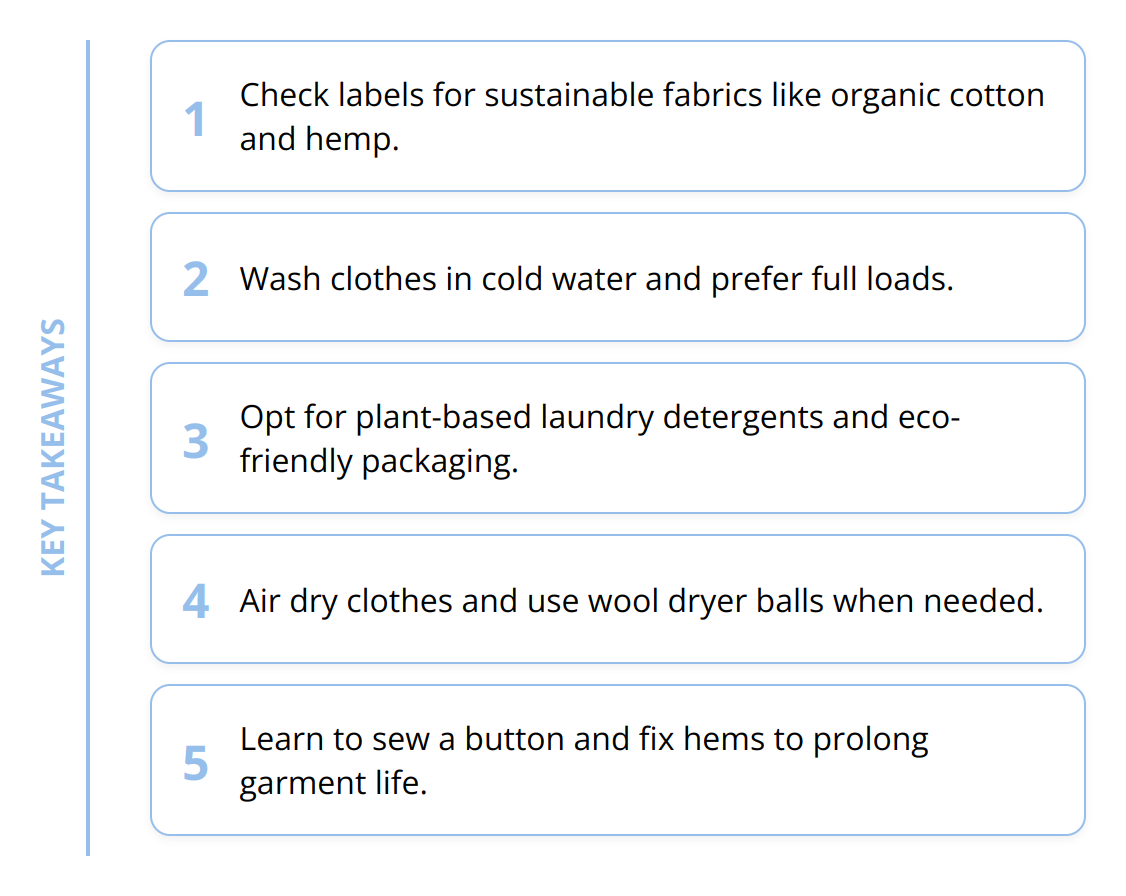At The A Team Cleaning Services, we believe in the power of making sustainable choices, especially when it comes to fabric care. Eco-friendly practices not only benefit our planet but also extend the life of our clothes.
In this blog post, we’ll guide you through selecting sustainable fabrics, adopting eco-friendly washing habits, and maintaining your garments to avoid replacing them prematurely. Let’s explore how simple changes can make a significant impact on the environment.
Eco-Friendly Fabric Choices
When it comes to making our wardrobes more sustainable, the fabric of our clothing plays a pivotal role. Choosing eco-friendly fabrics is not just a trend, it’s a necessity if we aim to reduce environmental impact.
Firstly, understanding which fabrics are sustainable is crucial. Sustainable fabrics are those that require less water, pesticides, and energy to produce. They also have a smaller carbon footprint compared to traditional materials. More importantly, these fabrics are often biodegradable or recyclable, meaning they won’t linger in landfills for centuries.
The benefits of opting for eco-friendly fabrics are immense. Not only do they help in conserving precious resources like water and energy, but they also reduce the amount of pollutants released into the environment. Clothing made from these materials tends to be more durable and less harmful to our skin due to the absence of harsh chemicals.
When shopping, look for common eco-friendly fabrics including organic cotton, linen, hemp, and Tencel. Organic cotton, for instance, is grown without toxic pesticides and uses far less water than conventional cotton. Linen, made from the flax plant, is not only lightweight and breathable but also grows with minimal water usage. Hemp is another powerhouse that requires no pesticides and little water, and it returns 60-70% of the nutrients it takes from the soil. Tencel, a fabric derived from wood pulp, stands out for its closed-loop production process that recycles almost all water and solvents.
Here are a few practical tips to integrate sustainable fabrics into your lifestyle:
- Always check the label for fabric content while shopping.
- Consider the durability of the fabric. Investing in high-quality, sustainable garments means you’ll buy less often.
- Be mindful of how the fabric was dyed. Opt for pieces dyed with low-impact or natural dyes to further reduce your environmental footprint.
For those eager to make a switch to eco-friendly fabrics but unsure where to start, our guides on sustainable cleaning routines and eco-friendly cleaning gadgets offer insights into maintaining these materials in a way that’s both effective and gentle on the planet.

By prioritizing eco-friendly fabrics, we make a direct contribution to a healthier planet. The shift to sustainable materials is not just a personal win in terms of reducing one’s carbon footprint, but a global victory for the environment.
Eco-Friendly Washing Practices
Adopting eco-friendly washing practices is not only beneficial for our clothes but also for the planet. Each step of washing, drying, and ironing offers a unique opportunity to conserve resources like water and energy. By making conscious choices, we actively contribute to environmental preservation.
Reducing water usage and energy consumption starts with how we use our washing machines. Modern washing machines are designed to be more efficient, yet how we use them can significantly impact their efficiency. Washing clothes in cold water is a smart choice. Not only does it save energy by not heating the water, but it also preserves the fabric of your clothes. Studies have shown that washing in cold water can reduce a household’s carbon footprint by up to 500 pounds of CO2 annually. Additionally, maxing out your machine’s capacity with full loads ensures that you’re using water and energy most efficiently. Despite common beliefs, full loads can be just as clean as smaller ones when sorted properly.
Choosing eco-friendly laundry detergents is another crucial step. Traditional detergents contain chemicals harmful to both our health and waterways. Opting for plant-based detergents or those certified by environmental groups can lessen this impact. Not only are they biodegradable, but they’re also free from phosphates and other pollutants. For insights into the safest and most effective products, explore our guide to biodegradable cleaning products.
When it comes to drying and ironing, rethink the need to iron and use a dryer. Air drying clothes is the most eco-friendly option. It significantly reduces energy consumption and is gentler on fabrics, extending the lifespan of your garments. If you must use a dryer, opt for wool dryer balls instead of dryer sheets. These balls naturally separate clothes in the dryer, reducing drying time and thereby saving energy. As for ironing, consider using a steam iron or a clothes steamer. Both methods are efficient for removing wrinkles without the high heat and energy use of traditional ironing.

Here are a few bullet points with additional practical tips:
- Wash clothes less frequently to reduce wear and tear and save water.
- Pre-treat stains to minimize washing intensity needed.
- Use a front-loading washing machine, which uses less water and energy than top-loaders.
- Skip the dryer whenever possible. If using, select the low heat setting.
- Choose concentrated detergents to reduce the amount of plastic packaging.
By integrating these eco-friendly washing practices into our routines, we take significant strides toward a more sustainable lifestyle. Not only do we save money in the long run by preserving the quality of our clothes, but we also protect our precious water and energy resources for future generations.
Repairing and Upcycling
Embracing the repair and upcycling of clothes is not just a cost-effective approach; it’s a bold step towards sustainability and environmental responsibility. The fashion industry is one of the largest polluters globally, and by choosing to repair and upcycle, we significantly reduce waste and the demand for new resources.
Benefits of Repairing and Upcycling Clothes
Repairing and upcycling garments offer immense benefits, both to the consumer and the environment. Firstly, it extends the life of clothing, reducing the need for frequent purchases. This directly translates to less clothing waste ending up in landfills, which is a win for the planet. Another advantage is the conservation of resources like water, energy, and raw materials typically used in manufacturing new garments. From an individual perspective, upcycling allows for creativity and personalization, giving old clothes a fresh, unique look.
Simple Repair Techniques Everyone Should Know
There are several basic repair skills that can save a garment from being discarded:
- Sewing a button: This is the most fundamental skill and can extend a piece of clothing’s life significantly.
- Fixing a hem: Learning to hem pants or skirts not only saves money but also customizes the length to suit your style.
- Mending tears: A simple needle and thread can mend a small tear, making clothes wearable again.
- Patching jeans: Denim can be easily revamped with patches, adding style while covering holes or worn areas.

For those interested in exploring more about sustainable garment care, consider reading about eco-friendly cleaning techniques which complement the repair and upcycling process by maintaining the integrity of fabrics.
How to Make Your Clothes Last Longer
In addition to repairing, there are proactive steps to ensure the longevity of your clothing:
- Wash with care: Follow the washing instructions on the label. Use cold water and eco-friendly detergents to preserve the fabric and color.
- Store properly: Keep clothes in a cool, dry place. Use padded hangers for delicate items to maintain their shape.
- Deal with stains immediately: Addressing stains immediately increases the chance of removal without damaging the fabric.
- Rotate your wardrobe: Regularly rotating clothes ensures even wear and tear, prolonging the overall life of your wardrobe.
By adopting these practices, not only do we nurture our personal style and save money, but we also take significant steps towards reducing our environmental footprint. Repairing and upcycling isn’t just a trend; it’s a movement towards mindful consumption, valuing what we own, and understanding the impact our choices have on the world around us.
Final Thoughts
Adopting eco-friendly habits in fabric care is vital for promoting a healthier planet and enhancing the longevity of our clothing. We at The A Team Cleaning Services are passionate advocates for sustainable living, recognizing its significance in our daily routines. This guide has outlined key practices from selecting sustainable fabrics to adopting eco-friendly washing habits, and emphasizing the importance of repairing and upcycling. Together, these actions contribute significantly to reducing our environmental footprint.

Importance of Eco-Friendly Fabric Care: It cannot be overstated how crucial sustainable fabric care is for the environment. By choosing eco-friendly fabrics, employing green washing practices, and repairing our clothes, we conserve energy, save water, and reduce chemical pollution. These efforts collectively play a profound role in mitigating fashion’s impact on our planet.
Key Practices for Sustainable Living:
- Opt for sustainable fabrics
- Use eco-friendly detergents
- Wash in cold water and air dry
- Repair and upcycle clothes
- Follow garment care instructions
By incorporating these practices into our lifestyle, we not only preserve the environment but also ensure that our clothing remains in excellent condition for a longer period. This approach towards fabric care is an investment in both our planet and personal wardrobe.
We encourage you to embrace these eco-friendly habits wholeheartedly. Start with small changes, like switching to cold washing, and gradually incorporate more sustainable practices. Every action counts, and together, we can make a substantial difference.
For more information on sustainable cleaning and fabric care, explore our site to discover practical guides and professional advice at The A Team Cleaning Services. With our professional house cleaning services, you also contribute to a cleaner, healthier living environment without the added stress of managing it all yourself. Our expert team uses professional-grade products and custom-tailored plans to fit your needs, ensuring a pristine, inviting space for you and your loved ones.
In conclusion, the journey towards a more sustainable lifestyle is ongoing and transformative. By adopting eco-friendly fabric care habits, we take important steps towards a greener, more conscientious future. Let’s collectively strive for a cleaner planet, starting with our wardrobes and extending to our homes.
